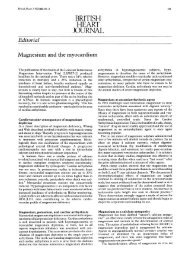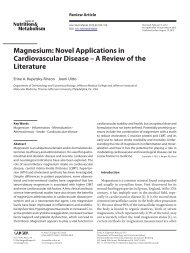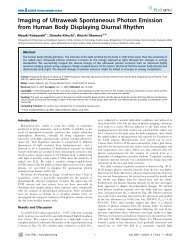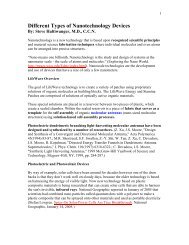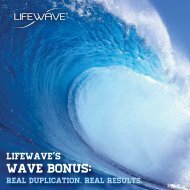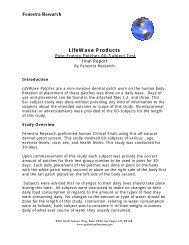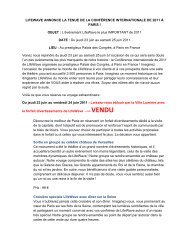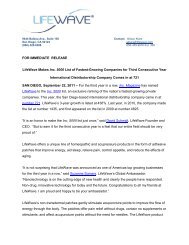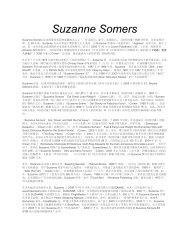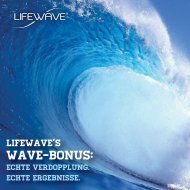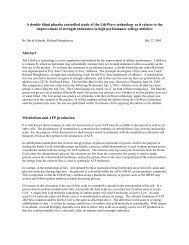Heart Rate Variability Enhancement Through ... - LifeWave
Heart Rate Variability Enhancement Through ... - LifeWave
Heart Rate Variability Enhancement Through ... - LifeWave
Create successful ePaper yourself
Turn your PDF publications into a flip-book with our unique Google optimized e-Paper software.
<strong>Heart</strong> <strong>Rate</strong> <strong>Variability</strong> <strong>Enhancement</strong> <strong>Through</strong>Nanotechnology:A Double-Blind Randomized-Control Pilot StudyThomas H. Budzynski, PhDHelen K. Budzynski, PhDKarl Maret, MDHsin-Yi (Jean) Tang, PhDABSTRACT. Background. The objective of this study was to test whether a proprietarynanotechnology skin patch produced for the purpose of increasing energy was also capableof modulating certain of the resonant frequencies of the body, promoting greater autonomicnervous system balance as reflected in heart rate variability (HRV).Method. The study is a treatment-control design with researchers blinded to the assignmentof subjects to either placebo or energy patch groups. The HRV measures were obtainedprior to and 15 min after the patches had been applied. The HRV was measured with aBioCom HRV system. The measurements were obtained in a treatment room with participantsresting in a lounge chair. Participants were solicited from volunteers who lived inthe Poulsbo area.Results. Analysis of the two groups indicated that when the experimental group HRVdata were examined for pre–post differences, the low frequency=high frequency (LF=HF)ratio decreased significantly (p < .01, one-tailed t test), the very low frequency (VLF)decreased significantly (p < .05), the LF decreased (p ¼ .011), LF norm decreased(p < .05), and HF norm increased (p < .05). It should be noted that the normalized LFand HF parameters represent relative values of each power component in proportion to totalpower minus the VLF component. This emphasizes the controlled and balanced behavior ofthe two branches of the autonomic nervous system. It tends to minimize the effect of changein total power on the values of LF and HF components (Task Force of the EuropeanSociety of Cardiology and the North American Society of Pacing and Electrophysiology,1996). The control group, however, showed no significant pre-post changes in theseparameters. Comparisons between energy and placebo patch groups reached statisticalsignificance (p < .05) only in the VLF parameter.Conclusion. These results suggest that <strong>LifeWave</strong> Energy Patches appear to act on the autonomiccardiovascular factors influencing heart rate variability in the hypothesized direction.This technology can be used to augment neurotherapy especially in cases characterized bychronic stress or fatigue factors.Thomas H. Budzynski is Affiliate Professor, University of Washington, Seattle, Washington.Helen K. Budzynski is Professor Emeritus, University of Washington, Seattle, Washington.Karl Maret is President, Dove Health Alliance, Aptos, California.Hsin-Yi (Jean) Tang is Assistant Professor, Seattle University, Seattle, Washington.Address correspondence to: Thomas H. Budzynski, PhD, Box 357263, Seattle, WA 98195(E-mail: tbudzyn@cs.com).Journal of Neurotherapy, Vol. 12(1) 2008Available online at http://jn.haworthpress.com# 2008 by The Haworth Press. All rights reserved.doi: 10.1080/10874200802219905 45
46 JOURNAL OF NEUROTHERAPYKEYWORDS. Biofield, heart rate variability, <strong>LifeWave</strong> energy patch, nanotechnology,neurofeedback, peak performance, stamina, stress reduction<strong>LifeWave</strong> PatchesINTRODUCTIONThe purpose of this study is to examine theeffect of <strong>LifeWave</strong> patent-pending nontransdermalpatches on heart rate variability inhumans (Schmidt, 2006). <strong>LifeWave</strong> patchesare a proprietary nanotechnology developedto enhance athletic performance by modulatingthe physiological functioning of musclecells. It is claimed that this is achievedthrough an increased rate of fatty acid betaoxidation,thereby enhancing muscular staminaand strength. This study was undertakento see whether use of these skin patches hasan effect on the cardiovascular system andautonomic nervous system, measurable byheart rate variability (HRV).The manufacturer of this technologyclaims that <strong>LifeWave</strong> patches ‘‘containorthomolecular compounds in water-basedsolutions designed to passively interact withthe human thermomagnetic field with thepurpose of creating a system of frequencymodulation, much in the same way a radiowave is modulated to communicate audioinformation’’ (Schmidt, 2006). The inventor,David Schmidt, claims to have achievedthis effect by treating L-amino acids andD-sugars in a proprietary manner and thenpackaging these solutions in nontransdermalpolyethylene films to be worn in a specificarrangement on the human body. Accordingto independent testing, no organicmolecules of the proprietary formula ofstereoisomers (isomeric molecules whoseatomic connectivity is the same but whoseatomic arrangement is different) are capableof migrating transdermally to the participants(Brown, 2006).According to Haltiwanger (2007), who isnow employed by the manufacturer, thepatches increase the products of metabolism,namely, adenosine triphosphate, calcium,and acetylcholine release. The organic materialsin the <strong>LifeWave</strong> sports patches aresaid to be specifically selected to matchresonant and sympathetic frequencies ofbiological components involved in mitochondrialenergy production. This is a newmechanism of action wherein specific stereoisomersdissolved in water exhibit liquid crystalproperties. When they crystallize out ofsolution, they form nanoscale-sized crystalsthat act as semiconducting biomolecularantennas capable of interacting with the oscillatingbioelectromagnetic field of the body(Nazeran, Chatlapalli, & Krishnam, 2005).A large percentage of users of <strong>LifeWave</strong>patches typically remark on the subjectivesense of increased energy, strength, andendurance, which can appear even at the firstuse of the patches. Some users notice that thepatches seem to allay the effects of dailystressors. Increases in sports performancehave been shown in studies carried out atseveral universities.It is hypothesized in this study that thesepatches are capable of promoting a generalizedbalance of other organ systems of thebody, specifically the cardiovascular andautonomic nervous system, measurablethrough changes in HRV. In 2005, Nazeranet al. reported effects on HRV of thosepatches in 2 individuals from a sample of 10healthy volunteers, showing data obtainedduring six different rest and exerciseconditions with and without energy patches.They found that compared to the placebopatch period, the low frequency=high frequency(LF=HF) ratio declined considerablyafter exercise and rest during the energypatch period. This would indicate that theenergy patches offered a better balancingof HF parasympathetic activity and LFsympathetic activity (Nazeran et al., 2005).The Nazeran study, like this study, wassupported by funds from <strong>LifeWave</strong>, Inc.Electrical and Magnetic Activitiesof the Human BodyBioelectric signals are generated in everycell, tissue, and organ of the human body.
Scientific Articles 47Each cell has a potential difference across itscell membrane that is maintained by differencesin concentration of ions on oppositesides of the membrane. Cells also have ionchannels in their biological membranes, andtiny electric currents passing through singleionic channels have been able to be demonstratedthrough specific patch clamp methods.This patch clamp technique is aprocedure in electrophysiology that allowsthe study of individual ion channels in cells.This has allowed bioelectromagnetism to beextended to molecular biology.Biomagnetic signals were not detecteduntil recently because of their extremelylow amplitude. The first pure biomagneticsignal, the magnetocardiogram, was onlydetected in 1963 by Baule and McFee(1963). An inductive detector coil used topick up the magnetic heart field needs acompensating identical coil with oppositeseries winding placed alongside to cancelcommon magnetic fields from externalsources. A remarkable increase in magneticsensitivity of biomagnetic measurementswas obtained with the introduction of theSuperconducting Quantum InterferenceDevice (SQUID), working with a very lowtemperature generated by liquid helium(Cohen, 1972; Zimmerman, Thiene, &Hardings, 1970). SQUIDs have been usedto measure magnetic fields of organs suchas hearts and brains. Wikswo, Barach, andFreeman (1980) were the first to measurethe extremely small magnetic field of a frognerve bundle. The aforementioned studiesdemonstrate the difficulties associated withthe measurement of extremely small biomagneticfields in living tissue.The body is sensitive to externally appliedelectromagnetic stimuli such as microcurrentelectrical signals and low-intensitymagnetic fields. The authors, as well asother researchers, have also manipulated electromagneticstimuli such as light and sound toalter brain waves thereby influencing brainperformance (Budzynski & Budzynski, 2000;Budzynski, Jordy, Budzynski, Tang, & Claypoole,1999; Siever, 2002). Microcurrent andcranial electrotherapy stimulation have beenused for control of pain, anxiety, depression,and insomnia (Kirsch, 2001). Microcurrenttherapy has also been used effectively forreducing signs and symptoms of muscle damage(Lambert, Marcus, Burgess, & Noakes,2002).If the technology devised by Schmidt iscapable of modulating the natural bioelectromagneticfield of the body, it maypotentially be useful in the future healthcare approaches, specifically, a possiblenondrug approach to alleviate the symptomsof stress and to increase athletic performance.The question is how canactivation of other biological functioning,such as autonomic nervous system activity,be understood as a consequence of Life-Wave’s technology through externallyapplied patches?According to a 2004 U.S. patent application(US2004=0057983 A1) filed by theinventor of the <strong>LifeWave</strong> technology, it isclaimed that when optically active substances,such as levo-rotary molecules(e.g., the amino acid L-glutamine) anddextro-rotary molecules (e.g., sugar orD-glutamic acid) are worn in patches on thehuman body, they are capable of exerting abeneficial effect on the supposed thermomagneticenergy of the human body. Thethermomagnetic effect, as it is normallyunderstood, was discovered in 1820 by theEstonian German medical doctor and physicistThomas Johann Seebeck. He found thatcertain dissimilar metals when joined in aclosed loop and having one junction heatedinduced a magnetic field in the nonheatedjunction. Whether very small thermomagneticeffects are capable of being produced in livingsystems through small temperature differentialsin different tissues is as yet unproven.Schmidt claimed in his patent application thathypothetical thermomagnetic fields from thehuman body can interact with stereoisomerspresent in the patches and induce beneficialresonance feedback effects. This mechanismof action has not been scientifically provento date.The Body’s Biofield Regulatory SystemsThere are other explanations of how<strong>LifeWave</strong> patches may affect the body.
48 JOURNAL OF NEUROTHERAPYDr. James Oschman, a biophysicist, drawsfrom Szent-Gyorgyi’s (1968) suggestionthat the proteins in the body aresemiconductors. He quoted Szent-Gyorgyiin stating, ‘‘Molecules do not have totouch each other to interact. Energy canflow through the electromagnetic field. ...The electromagnetic field, along with water,forms the matrix of life. Water can formstructures that transmit energy’’ (Oschman,2000, p. 60). Each component of theorganism, even the smallest cell, is immersedin and generates a constant stream ofvibratory information. <strong>Through</strong> energytherapies it is said that one can restore andbalance the vibratory circuitry (Oschman,2000).All living systems can sense minutechanges in their electromagnetic environmentand have many biosensors that arenear to being quantum sensitive (Smith,1986). Human beings have demonstratedelectromagnetic sensitivity to a wide rangeof both static and dynamic fields. Thisincludes the earth’s geomagnetic field anda wide variety of man-made electromagneticradiation. Smith and Best (1989)demonstrated that sensitive individualscan respond adversely to very low levelelectromagnetic fields. In addition, thereare many types of cellular resonancesincluding low-frequency surface tensionwave resonances and higher frequencymembrane and microtubule resonances.Control systems in the body exist in complexfeedback networks capable of beinginfluenced by external and internal bioelectromagneticfields. These enzymatic controlsystems are embedded in the complexregulatory control systems that operatein the connected tissue matrix. Thishas been described in detail by Pischingerand Heine (1991). They named these regulatorypathways in the connective tissuematrix the ‘‘ground regulation system.’’This regulatory system is capable of affectingother organ systems in the bodysuch as the autonomic nervous systemand cardiovascular system. These complexregulatory pathways might be anotherexplanation for the reported effects of<strong>LifeWave</strong> patches.Rhythm and <strong>Variability</strong> WithinBody SystemsIf we accept that there is a range of regulatoryfrequencies operative in varioustissues or organs, then the question is howto understand the way vibrational activityoperates in these systems. In fact, highvariability of oscillations and the integratedphysiologic activities of an organ, system,or complex of systems in the body is associatedwith healthy functioning. <strong>Variability</strong>represents the capacity for systems to alterin adaptation to environmental living conditions.Giardino, Lehrer, and Feldman(2000) referred to these moment-to-momentactions of living systems as oscillations.These oscillations within cells, body systems,or multiple interacting systems are selfregulatingand responsive to demandswhether for chemicals, energy, nutrients, orthe dynamics of changing body functions.Whereas oscillations are rapid changes inbody functioning, circadian rhythms arelonger in time periodicities allowing forbody rest and repair. These oscillations andrhythms operate within observed ranges.Outside of these ranges bodily systems canproduce negative reactions with other interactingsystems. Disease susceptibility, andultimately dysfunctional disease states, showevidence that these oscillations and rhythmsbecome less flexible and less variable. Thegoal for healthy functioning is to achieveflexibility and balance of functioning ofinteracting systems to restore and maintainadaptability.HRVAn example of this concept of flexibility inhealth functioning can be demonstrated in areview of the cardiovascular system whereinthe heart rate, circulatory pressure and flow,and peripheral resistance make constantadaptations in response to environmentalchallenges. One can trace the pathology ofhypertension to obtain an insight on how,when exceeding and heightening the midpointof the normal oscillations of thecardiovascular and neurochemical systems
Scientific Articles 49over an extended period, the integration isimpaired. In the cardiovascular system,as in almost all other bodily systems, theautonomic system plays a major role inself-regulation. The two divisions of theautonomic nervous system, the sympatheticand parasympathetic, maintain the neededrate of blood flow through the variabilityin heart rate control. Thus flexibility in systemsas measured by variability provides aconcept for healthy functioning.Over the last decade or so, a cardiovascularphenomenon called HRV has generateda great deal of research because of its strongidentification with cardiovascular fitness.The parameter HRV is derived from theelectrocardiograph signal. It reflects the factthat the heart rhythm is adjusted in thesinoatrial node by the sympathetic andparasympathetic nerves of the autonomicnervous system. In a healthy individual theheart rate speeds up when the personexhales and it slows during inhalation.If viewed on a computer screen, thecardiotach signal (which is a transformationof beat-to-beat interval time into a DClevel) of a healthy, relaxed individualappears to be sinusoidal (rhythmicallycyclical) and synchronized with the respiratorycycle. It is called the respiratory sinusarrhythmia.Young, healthy hearts mayshow as much as a 30 beat-per-minutepeak-to-peak difference. Less healthy heartswill show lesser degrees of this sinusoidalwaveform. The HRV thus can be seen asan indicator of overall health (Cowan,1995; Odemuyiwa, 1995).Measurement of <strong>Heart</strong> <strong>Rate</strong> <strong>Variability</strong>The BioCom is a biofeedback systemdesigned to quantify and feed back cardiovascularparameter information. The programperforms a spectral analysis offrequencies derived from electrocardiographtracings, providing measures of very low frequency(VLF), 0.0033 to 0.04 Hz; LF, 0.04 to0.15 Hz; HF, 0.15 to 0.4 Hz; and total power,0.0 to 0.4 Hz. The VLF is primarily anindex of sympathetic activity, whereas theHF is representative of parasympatheticinfluence. The LF range is more complex,as it can reflect a mixture of sympatheticand parasympathetic activity (McCraty,Atkinson, & Tomasino, 2001). An idealspectral value is 0.1 Hz, indicating a balanceof the sympathetic and parasympatheticnervous systems as seen in healthy individualswhen they are engaged in steady diaphragmaticbreathing of approximately sixbeats per minute.Biological factors such as age, gender, andethnicity are known to affect HRV, as doa variety of health problems and medications.In general, as people age, HRVdecreases after the 4th or 5th decade.Women tend to have lower LF values thanmen, although this difference disappearsafter midlife. Trained athletes have higherHRV than sedentary individuals. Anotherstudy showed that exercise training increasedHRV in healthy older adults. Even patientswith coronary artery disease with just 2months of exercise training increasedtheir HRV (Goldsmith, Bigger, Steinman,& Fleiss, 1992; Iellamo, Legramante,Massaro, Raimondi, & Galante, 2000).A variety of analyses have been appliedto the R–R interval (the interval betweenR waves in the QRS complex) to deriveparameters that have correlated with anumber of variables. There are two types ofHRV measurement: time domain analysisand frequency domain analysis (powerspectral analysis). Time domain focuseson the measurement of time intervalsbetween R–R intervals, whereas frequencydomain analysis separates the parasympatheticand sympathetic components of autonomiccontrol. Frequency domain analysisinvolves two basic parameters of measurement:HF (0.15–0.40 Hz) and LF (0.04–0.15 Hz). In general HF values are relatedto vagal tone (parasympathetic). LF valuesare associated primarily with sympatheticneural activity. The ratio of LF=HF is asensitive indicator of balance in the cardiovascularsystem.In this study, the frequency domain parametersof HRV were dependent variablesutilized to test the outcome of <strong>LifeWave</strong>energy patches on HRV cardiovascularfunctioning.
50 JOURNAL OF NEUROTHERAPYPilot Data. Hypotheses for this studywere derived from the results obtained fromanecdotal clinical sessions wherein clientswere tested with a baseline period and thenagain approximately 15 to 30 min after wearingthe <strong>LifeWave</strong> energy patches. It was alsoobserved that when clients thought about disturbingevents, the VLF (sympathetic tone)increased in the HRV spectral display. TheVLF decreased when relaxing scenes wereimaged. At the same time, the HF (high-frequencyparasympathetic tone) increased.When the <strong>LifeWave</strong> patches were applied,the VLF decreased as well, indicating to theinvestigators that some changes were beingmade in the LF=HF ratio. From these pilotdata the following hypotheses were derived:As a result of wearing the real patches:1. LF=HF ratio will decrease, indicating betterbalance of stimuli to the heart.2. VLF will decrease, indicating decreasedinput of sympathetic stimuli to the heart.3. LF norm will decrease, using normalizedfigures to take into the account the totalpower that differed widely amongindividuals.4. HF norm will increase, also normalizedfor the same reason as just stated.It is expected that the control (placebo)group will show significantly less change inthe hypothesized direction.ParticipantsMETHODInterested adults were sought from signupsheets at local health clubs and communitycenters. Forty adult participantswere chosen and divided randomly into twogroups of 20 participants each. The participantconsent form was read and signed byeach individual. Participants who wereundergoing treatment for health problemsof a serious nature were excluded as wereany participants using beta blocker medications.The E group (who received the real<strong>LifeWave</strong> patches) had an average age of49 and consisted of 9 women and 11 men.The C group (who were given the placebopatches) had an average age of 48 and consistedof 16 women and 4 men. Participantshad the right to terminate their participationat any point in the procedure upon request.DesignThe study used double-blind and randomizedcontrol design. There were 5 min ofHRV measured before the <strong>LifeWave</strong> energyor placebo patch application. Both experimentaland control group had the left andright energy or placebo patches applied overthe lung meridian (just below the locationwhere the collarbone and the shoulder bonemeet). Left and right patches refer to the factthat they contain proprietary formulas ofbiomolecular stereoisomers, which whendissolved in water exhibit liquid crystalproperties. The white patches containL-stereoisomers and the tan patches containD-stereoisomers. The white patches havebeen found to be most effective when placedon the skin over acupuncture points that areelectrically positive, whereas the tan patchesare most effective when placed over negativeacupuncture points. The experimenter wasblinded as to whether he was giving outa placebo or real patch pair. After 15 min,the participants had their HRVs measuredonce more. Following this procedure eachparticipant received 15 <strong>LifeWave</strong> energypatch pairs as a gift for their participation.ProcedureBioCom, a biofeedback system designedto quantify and feed back cardiovascularparameter information, was used. Theprogram performs a spectral analysis offrequencies derived from electrocardiographtracings. An ideal spectral value is dominantat 0.1 Hz, indicating a balance of the sympatheticand parasympathetic nervoussystems, as seen in healthy individuals whenthey are engaged in steady diaphragmaticbreathing of approximately six beats perminute.
Scientific Articles 51FIGURE 1. Mean and standard error (SE) low frequency (LF)=high frequency (HF) post-pre differences.FIGURE 2. Mean and standard error very low frequency (VLF) post-pre differences.Data AnalysisTo see if patches appeared to producea change in HRV parameters, the analysisincluded several paired sample t tests todetermine pre–post differences for HRVparameters in each group. These pre-postdifferences for all parameters were thencompared between the two groups. Inaddition, group means with standard errorsand medians of each parameter weregraphed (Figures 1–4).Pre–post differences and between groupdifferences were tested with t tests. Meansand standard errors for each group areshown in Figures 1 to 4. Table 1 gives statisticalresults including median values foreach group.RESULTSPost–pre results for all four frequencyvariables (LF=HF, VLF, LF norm, and HF
52 JOURNAL OF NEUROTHERAPYFIGURE 3. Low frequency (LF) norm mean and standard error post-pre differences.FIGURE 4. High frequency (HF) norm mean and standard error post-pre differences.norm) were significant (p < .05) for theexperimental group (see Table 1). However,post–pre data for the control group did notmeet significance in any variable.Comparisons of post–pre differencesbetween groups showed significance only inthe VLF parameter, that is, the VLF in theexperimental group decreased significantly(p < .05) when compared to the controlgroup. LF=HF, VLF, LF norm, and HFnorm means and standard errors are shownin Figures 1 to 4.Figure 5 is a reproduction of the majorpart of the data sheet as generated by theBioCom program. A pre- and postsessionare shown. Ideally, the small square shouldbe located inside the center square. In thissample (drawn from a participant in the
Scientific Articles 53TABLE 1. Summary of mean and median change in heart rate variability parameters.Experimental GroupControl GroupPre Post M Change Pre Post M ChangeLF=HFM (SE) 4.8 3.2 1.57 (0.73) 4.2 3.2 1.01 (0.83)Mdn 1.8 1.2 0.4 1.5 1.6 0.1M (SE) 286 219.9 66.00 (71.5) 287.7 391.5 þ103.7 (79)Mdn 235 127.1 107.9 101 177.2 þ76.2LF normM (SE) 61.2 53.3 7.90 (4.4) 65.4 63 2.4 (3)Mdn 63.4 54.8 8.6 61.5 64.2 2.7HF normM (SE) 38.8 47 þ8.30 (4.8) 34.6 37.1 þ2.5 (3.2)Mdn 36.2 45.2 þ9 38.5 35.9 2.6Note. LF=HF ¼ low frequency=high frequency; VLF ¼ very low frequency.FIGURE 5. Partial BioCom data sheet.experimental group) the square moves froma baseline outside the square to inside afterthe experimental patch period. The powerspectral density units are msec squared=Hz.Note the computer-generated summarystatement under each figure, that is, thebaseline statement indicates sympatheticdominance, whereas the postexperimental
54 JOURNAL OF NEUROTHERAPYperiod generates a computer software statement,‘‘Maintaining balance between sympatheticand parasympathetic branches ....’’Note also the spike in the VLF portion(extreme left) of the power spectral densitydiagram at baseline and the fact that it is gonein the experimental period (after 15 min ofwearing the <strong>LifeWave</strong> patches) in the bottomgraph.DISCUSSIONLifewave Energy patches can result ina decrease of sympathetic drive to the heart.This may explain anecdotal reports from therapyclients that they feel less stressed whenwearing them. Even though the betweengroupstatistics did not prove to be significantin three of four of the variables, means and inparticular medians showed definite trends inthe hypothesized directions. The energypatches are now used in our clinic to helpidentify a sudden increase or decrease in anxietyor stress. For example, the VLF spikeoften appears during therapy sessions whena client experiences stress or anxiety. It tendsto diminish or disappear when they relax.Lifewave patches may serve to augmentother therapy protocols including neurotherapy.It is suggested that future studies of thistechnology include other physiological measuresin addition to HRV.REFERENCESBaule, G., & McFee, R. (1963). Detection of the magneticfield of the heart. American <strong>Heart</strong> Journal, 66,95–96.Brown, R. S. (2006). Patch permeability. Report ofresults: MVA6158. La Jolla, CA: LifewaveProducts. Retrieved September 27, 2007, fromhttp://www.lifewave.com/pdf/Research/Research004-MVAStudy11-23-04.pdfBudzynski, T., & Budzynski, H. K. (2000). Reversingage-related cognitive decline: Use of neurofeedbackand audio-visual stimulation. Biofeedback, 28(3),19–21.Budzynski, T., Jordy, J., Budzynski, H. K., Tang, H.Y., & Claypoole, K. (1999). Academic performanceenhancement with photic stimulation and EDRfeedback. Journal of Neurotherapy, 2, 11–21.Cohen, D. (1972). Magnetoencephalography: Detectionof the brain’s electrical activity with a superconductingmagnetometer. Science, 175(22), 664–666.Cowan, M. J. (1995). Measurement of heart ratevariability. Western Journal of Nursing Research,17(1), 32–48.Giardino, N. D., Lehrer, P. M., & Feldman, J. M.(2000, March–April). Cardiovascular resonantfrequency biofeedback. Paper presented at themeeting of the Association of Applied Psychophyiologyand Biofeedback, Wheat Ridge, CO.Goldsmith, R. L., Bigger, J. T., Jr., Steinman, R. C., &Fleiss, J. L. (1992). Comparison of 24-hour parasympatheticactivity in endurance-trained anduntrained young men. Journal of the AmericanCollege of the Cardiology, 20(3), 552–558.Haltiwanger, S. (2007). The science behind <strong>LifeWave</strong>technology patches. Energy-patches. RetrievedSeptember 27, 2007, from http://energy-patches.biz/html/the_science.htmlIellamo, F., Legramante, J. M., Massaro, M.,Raimondi, G., & Galante, A. (2000). Effects of aresidential exercise training on baroreflex sensitivityand heart rate variability in patients with coronaryartery disease: A randomized, controlled study.Circulation, 102(21), 2588–2592.Kirsch, D. L. (2001). Microcurrent electrical therapymechanisms and result. Practical Pain Management,29–33.Lambert, M. I., Marcus, P., Burgess, T., & Noakes, T.D. (2002). Electro-membrane microcurrent therapyreduces signs and symptoms of muscle damage.Medicine & Science in Sports & Exercise, 34(4),602–607.McCraty, R., Atkinson, M., & Tomasino, D. (2001).Science of the heart: Exploring the role of the heartin human performance. Boulder Creek, CO: Instituteof <strong>Heart</strong>Math. Retrieved September 27, 2007, fromhttp://www.heartmath.org/research/science-of-theheart/index.htmlNazeran, H., Chatlapalli, S., & Krishnam, R. (2005,September). Effect of novel nanoscale energy patcheson spectral and nonlinear dynamic features of heartrate variability signals in healthy individuals duringrest and exercise. Paper presented at the 27thAnnual Conference of IEEE Engineering in Medicineand Biology, Shanghai, China.Odemuyiwa, O. (1995). Effect of age on heart ratevariability. In M. Malik & A. J. Camm (Eds.),<strong>Heart</strong> rate variability (pp. 235–240). New York:Futura.Oschman, J. L. (2000). Energy medicine: The scientificbasis. Edinburgh, UK: Churchill Livingstone.Pischinger, A., & Heine, H. (1991). The extracellularmatrix and ground regulation. New York: NorthAtlantic Books. (English transl. 2007).
Scientific Articles 55Schmidt, D. (2006). A brief introduction to the Life-Wave2 technology and explanation of the phenomenaassociated with its use. La Jolla, CA: LifewaveProducts. Retrieved September 27, 2007, fromhttp://lifewavenc.com.Siever, D. (2002). The rediscovery of light and soundstimulation. Edmonton, Canada: ComptronicsDevices Limited.Smith, C. W. (1986). High sensitivity biosensorsand weak environmental stimuli. In Joint Colloquiumof the Dielectric Society Annual Meetingand 3rd University of Wales Conference on Biotechnology(pp. 17–19). Bangor: Industrial BiotechnologyWales.Smith, C. W., & Best, S. (1989). Electromagnetic man:Health and hazard in the electrical environment. NewYork: St. Martin’s.Szent-Gyorgyi, A. (1968). Bioelectronics. New York:Academic.Task Force of the European Society of Cardiology andthe North American Society of Pacing and Electrophysiology.(1996). <strong>Heart</strong> rate variability standardsof measurement, physiological interpretation, andclinical use (M. Malik, chairman). Circulation, 93,1043–1065.Wikswo, J. P., Barach, J. P., & Freeman, J. A. (1980).Magnetic field of a nerve impulse: First measurements.Science, 208(4439), 53–55.Zimmerman, J. E., Thiene, P., & Hardings, J. (1970).Design and operation of stable RF-biasedsuperconducting point-contact quantum devices,and a note on the properties of perfectly cleanmetal contacts. Journal of Applied Physics, 41,1572–1580.



